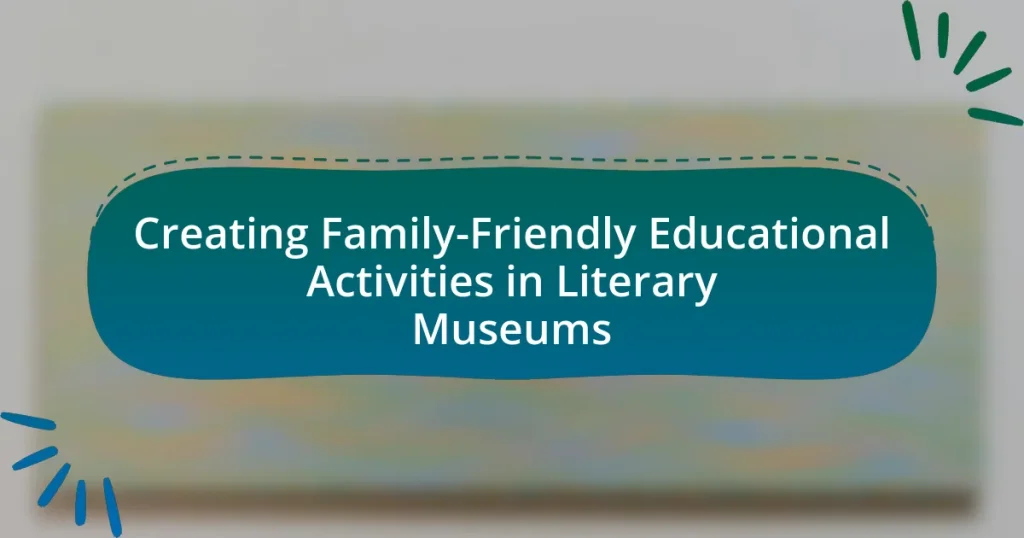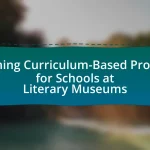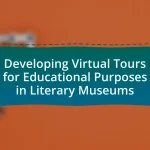The article focuses on creating family-friendly educational activities in literary museums, highlighting the importance of interactive storytelling sessions, guided tours, and hands-on workshops that promote literacy and foster a love for literature among families. It discusses how these activities enhance learning experiences by encouraging collaboration and engagement across different age groups. Additionally, the article addresses challenges faced by museums in developing such programs, strategies for effective family engagement, and the role of technology in enriching educational offerings. Key examples of successful initiatives and best practices for inclusivity and accessibility are also outlined, emphasizing the significance of community involvement and feedback in program development.
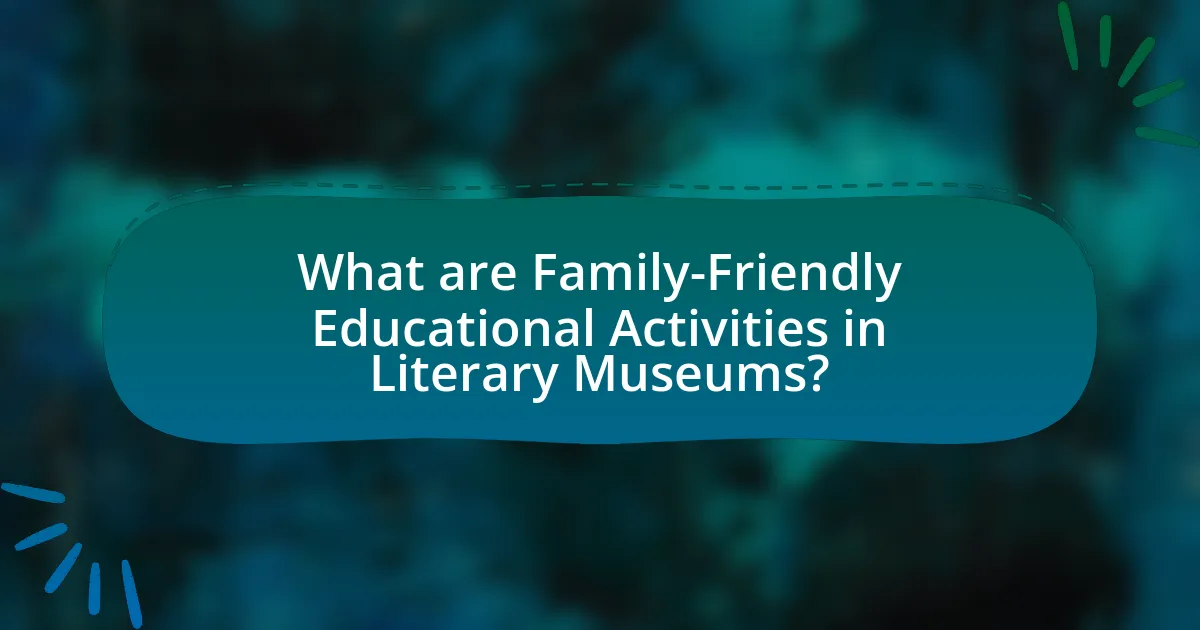
What are Family-Friendly Educational Activities in Literary Museums?
Family-friendly educational activities in literary museums include interactive storytelling sessions, guided tours tailored for children, and hands-on workshops that encourage creative writing. These activities engage families by making literature accessible and enjoyable, fostering a love for reading and writing. For instance, many literary museums offer programs where children can participate in dramatizations of famous literary works, allowing them to immerse themselves in the stories. Additionally, workshops often focus on crafting stories or poems, which can enhance children’s literacy skills while being fun and engaging. Such initiatives are supported by educational research indicating that interactive learning experiences significantly improve comprehension and retention in young learners.
How do these activities enhance the learning experience for families?
Family-friendly educational activities in literary museums enhance the learning experience for families by fostering engagement and collaboration among family members. These activities encourage interactive learning, allowing families to explore literature and history together, which strengthens their understanding and appreciation of the subject matter. Research indicates that collaborative learning environments improve retention rates and critical thinking skills, as families discuss and reflect on their experiences during these activities. For instance, hands-on workshops or storytelling sessions enable families to connect personally with the material, making the learning experience more memorable and impactful.
What types of educational activities are commonly offered?
Commonly offered educational activities in literary museums include guided tours, workshops, storytelling sessions, and interactive exhibits. Guided tours provide visitors with insights into the museum’s collections and the lives of authors, enhancing their understanding of literary history. Workshops often focus on writing skills or literary analysis, allowing participants to engage creatively with texts. Storytelling sessions cater to families and children, fostering a love for literature through engaging narratives. Interactive exhibits encourage hands-on learning, making literature accessible and enjoyable for all ages. These activities are designed to promote literacy and appreciation for literature within a family-friendly environment.
How do these activities cater to different age groups?
Activities in literary museums cater to different age groups by offering tailored experiences that align with developmental stages and interests. For example, interactive storytelling sessions engage young children through imaginative play, while guided tours with age-appropriate discussions appeal to older children and teenagers, fostering critical thinking about literature. Additionally, workshops that focus on writing or art allow adults to explore their creativity, ensuring that each age group finds relevant and stimulating content. Research indicates that educational activities designed with specific age considerations enhance learning outcomes, as evidenced by studies showing increased engagement and retention in age-appropriate settings.
Why are literary museums important for family education?
Literary museums are important for family education because they provide interactive and engaging environments that foster a love for literature and learning among all family members. These museums often feature exhibits that highlight the lives and works of authors, allowing families to explore literary history together. For instance, many literary museums offer hands-on activities, workshops, and storytelling sessions that cater to various age groups, making literature accessible and enjoyable for children and adults alike. Research indicates that family visits to cultural institutions, such as literary museums, enhance children’s literacy skills and promote critical thinking, as families discuss and reflect on the exhibits they encounter.
What role do literary museums play in promoting literacy?
Literary museums play a crucial role in promoting literacy by providing interactive and educational experiences that engage visitors with literature. These institutions often host workshops, readings, and exhibitions that encourage reading and writing skills among diverse audiences, including children and families. For instance, programs designed for young visitors can foster a love for books and storytelling, which are essential components of literacy development. Additionally, literary museums frequently collaborate with schools to create curriculum-based activities that enhance students’ understanding of literary works, thereby reinforcing literacy in educational settings.
How can literary museums foster a love for reading among children?
Literary museums can foster a love for reading among children by providing interactive and engaging educational activities that connect literature to their experiences. These activities can include storytelling sessions, hands-on workshops, and themed exhibitions that encourage children to explore books in a fun and relatable way. For instance, research shows that children who participate in interactive reading programs are more likely to develop positive attitudes towards reading, as these experiences make literature accessible and enjoyable. Additionally, literary museums can collaborate with schools to create programs that align with educational curricula, further enhancing children’s interest in reading through relevant and meaningful content.
What challenges do literary museums face in creating family-friendly activities?
Literary museums face several challenges in creating family-friendly activities, primarily including resource limitations, audience engagement, and content appropriateness. Resource limitations often restrict the ability to develop diverse programming that appeals to families, as many museums operate on tight budgets and may lack staff dedicated to family-oriented initiatives. Audience engagement poses a challenge because museums must balance educational content with entertainment to capture the interest of both children and adults, which can be difficult given varying attention spans and interests. Additionally, ensuring content appropriateness for different age groups requires careful curation to avoid themes that may not resonate with younger audiences, complicating the development of inclusive activities. These challenges highlight the complexities literary museums encounter in their efforts to create engaging and educational experiences for families.
How can museums overcome budget constraints?
Museums can overcome budget constraints by diversifying their funding sources. This includes seeking grants from government bodies, private foundations, and corporate sponsorships, which can provide significant financial support. For instance, the National Endowment for the Arts offers grants specifically for educational programs, allowing museums to enhance their family-friendly activities without solely relying on ticket sales or donations. Additionally, museums can implement cost-saving measures such as collaborating with local schools for joint programs, which can reduce operational costs while increasing visitor engagement.
What strategies can be employed to engage families effectively?
To engage families effectively, literary museums can implement interactive programs that cater to diverse age groups and interests. These programs can include hands-on workshops, storytelling sessions, and guided tours that encourage participation from both children and adults. Research indicates that interactive learning experiences enhance family engagement; for instance, a study by the National Endowment for the Arts found that family participation in arts activities leads to increased cultural appreciation and bonding. By creating an inclusive environment that fosters collaboration and creativity, literary museums can strengthen family connections and enhance the overall educational experience.
How can literary museums collaborate with educators to enhance activities?
Literary museums can collaborate with educators by developing joint programs that integrate museum resources into classroom curricula. This collaboration can include workshops where educators receive training on how to utilize literary artifacts and exhibits to enhance student engagement and learning outcomes. For instance, the American Alliance of Museums emphasizes the importance of partnerships between museums and schools, noting that such collaborations can lead to innovative educational experiences that align with educational standards. Additionally, literary museums can provide educators with access to primary sources and expert-led discussions, fostering a deeper understanding of literary history and its relevance to contemporary issues.
What resources are available for developing family-friendly programs?
Resources available for developing family-friendly programs in literary museums include educational toolkits, community partnerships, and funding opportunities. Educational toolkits often provide guidelines and activities tailored for families, enhancing engagement through interactive learning experiences. Community partnerships with local schools and organizations can facilitate outreach and participation, ensuring programs meet the needs of families. Additionally, funding opportunities from grants and cultural organizations support the development and sustainability of these programs, allowing museums to create enriching environments for family learning.
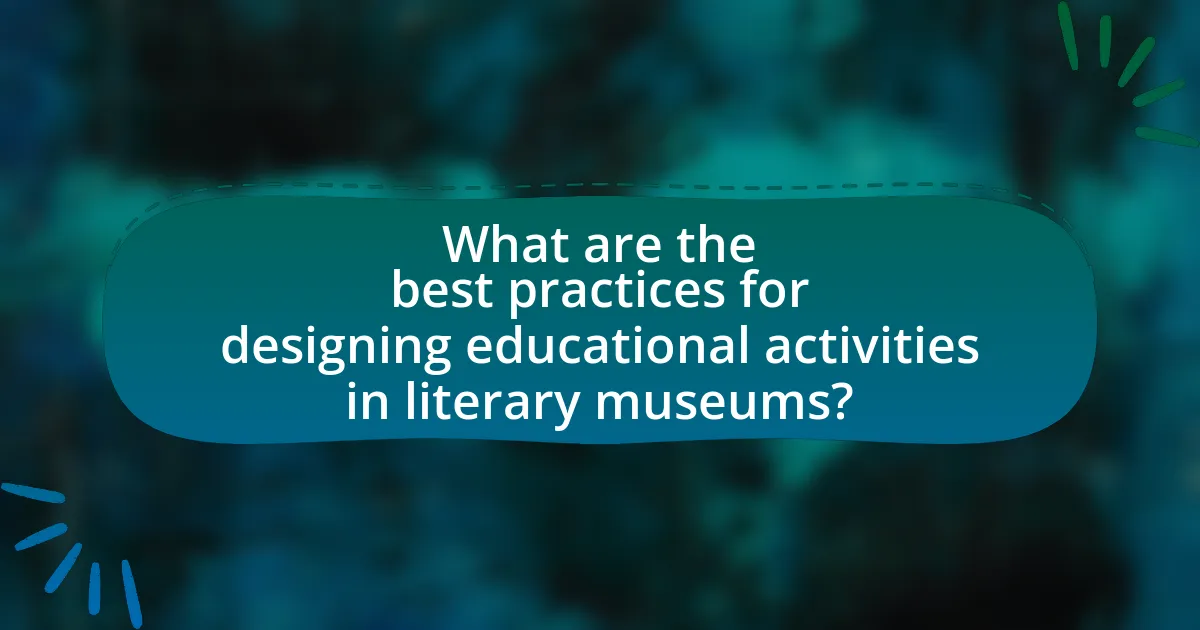
What are the best practices for designing educational activities in literary museums?
The best practices for designing educational activities in literary museums include engaging storytelling, interactive exhibits, and community involvement. Engaging storytelling captivates visitors by connecting them emotionally to the literature and authors featured in the museum, enhancing their learning experience. Interactive exhibits allow visitors to participate actively, fostering a deeper understanding of literary concepts and themes. Community involvement ensures that activities are relevant and resonate with local audiences, as seen in successful programs that incorporate local authors and literary traditions. These practices are supported by research indicating that interactive and community-focused educational experiences significantly improve visitor engagement and learning outcomes in museum settings.
How can museums ensure inclusivity in their programs?
Museums can ensure inclusivity in their programs by actively engaging diverse communities in the planning and execution of their activities. This approach includes conducting outreach to underrepresented groups, incorporating multilingual resources, and providing accessible facilities and materials. For instance, a study by the American Alliance of Museums found that museums that involve community members in program development see increased participation from those communities, demonstrating the effectiveness of collaborative efforts in fostering inclusivity.
What considerations should be made for children with disabilities?
Considerations for children with disabilities in creating family-friendly educational activities in literary museums include ensuring accessibility, providing appropriate accommodations, and fostering an inclusive environment. Accessibility involves physical features such as ramps, elevators, and accessible restrooms, which are essential for children with mobility impairments. Accommodations may include sensory-friendly spaces, assistive technologies, and tailored programming that meets diverse learning needs. Fostering an inclusive environment requires staff training on disability awareness and sensitivity, ensuring that all children feel welcomed and valued. Research indicates that inclusive practices enhance participation and learning outcomes for children with disabilities, making these considerations vital for effective educational programming.
How can cultural diversity be represented in activities?
Cultural diversity can be represented in activities through the inclusion of various cultural perspectives, traditions, and practices in the programming. For instance, literary museums can host events that feature authors from different cultural backgrounds, showcasing their works and the unique narratives they bring. Additionally, interactive workshops can be organized where participants engage in traditional storytelling, art, or music from diverse cultures, allowing for experiential learning. Research indicates that such inclusive activities not only enhance understanding but also foster appreciation for different cultures, as evidenced by studies showing increased cultural awareness among participants in multicultural programs.
What role does technology play in family-friendly educational activities?
Technology enhances family-friendly educational activities by providing interactive and engaging learning experiences. It facilitates access to digital resources, such as e-books and educational apps, which can make literature more accessible and enjoyable for families. For instance, augmented reality applications in literary museums allow families to interact with exhibits in immersive ways, fostering deeper understanding and engagement with the material. Research indicates that 70% of parents believe technology can enhance their children’s learning experiences, demonstrating its significant role in modern education.
How can digital tools enhance the learning experience?
Digital tools can enhance the learning experience by providing interactive and engaging content that caters to diverse learning styles. For instance, virtual reality (VR) applications allow users to immerse themselves in literary worlds, making stories more relatable and memorable. Research indicates that students using VR for educational purposes show a 30% increase in retention rates compared to traditional methods. Additionally, digital platforms facilitate collaboration through forums and social media, enabling learners to share insights and discuss literary themes, which fosters a deeper understanding of the material.
What are some examples of successful tech integration in museums?
Successful tech integration in museums includes the use of augmented reality (AR) and virtual reality (VR) to enhance visitor experiences. For instance, the British Museum implemented AR to allow visitors to interact with ancient artifacts in a more immersive way, providing contextual information and historical narratives. Additionally, the Smithsonian National Museum of Natural History developed a VR experience that enables users to explore the museum’s exhibits from home, significantly increasing accessibility and engagement. These examples demonstrate how technology can enrich educational activities and make museum visits more interactive and informative.
How can feedback from families improve educational offerings?
Feedback from families can significantly enhance educational offerings by providing insights into their needs and preferences. When families share their experiences and suggestions, educational institutions can tailor programs to better engage children and parents, ensuring that activities are relevant and enjoyable. For instance, a study by the National Parent Teacher Association found that schools that actively seek and incorporate family feedback see improved student performance and satisfaction. This evidence supports the notion that family input is crucial for developing effective educational strategies that resonate with the community.
What methods can be used to gather feedback effectively?
Surveys and interviews are effective methods for gathering feedback. Surveys can be distributed online or in-person, allowing participants to provide structured responses that can be quantitatively analyzed. For instance, a study by the American Educational Research Association found that well-designed surveys yield high response rates and valuable insights into participant experiences. Interviews, on the other hand, facilitate in-depth discussions, enabling facilitators to explore participants’ thoughts and feelings more comprehensively. According to research published in the Journal of Museum Education, interviews can uncover nuanced feedback that surveys might miss, thus enriching the understanding of visitor experiences in educational settings.
How can museums implement changes based on feedback?
Museums can implement changes based on feedback by systematically collecting, analyzing, and acting on visitor input. This process involves utilizing surveys, comment cards, and digital platforms to gather insights on visitor experiences and preferences. For instance, the American Alliance of Museums emphasizes the importance of visitor feedback in shaping programs and exhibitions, highlighting that museums that actively engage with their audience can enhance educational offerings and improve visitor satisfaction. By prioritizing this feedback loop, museums can adapt their family-friendly educational activities to better meet the needs and interests of diverse audiences, ultimately fostering a more inclusive and engaging environment.
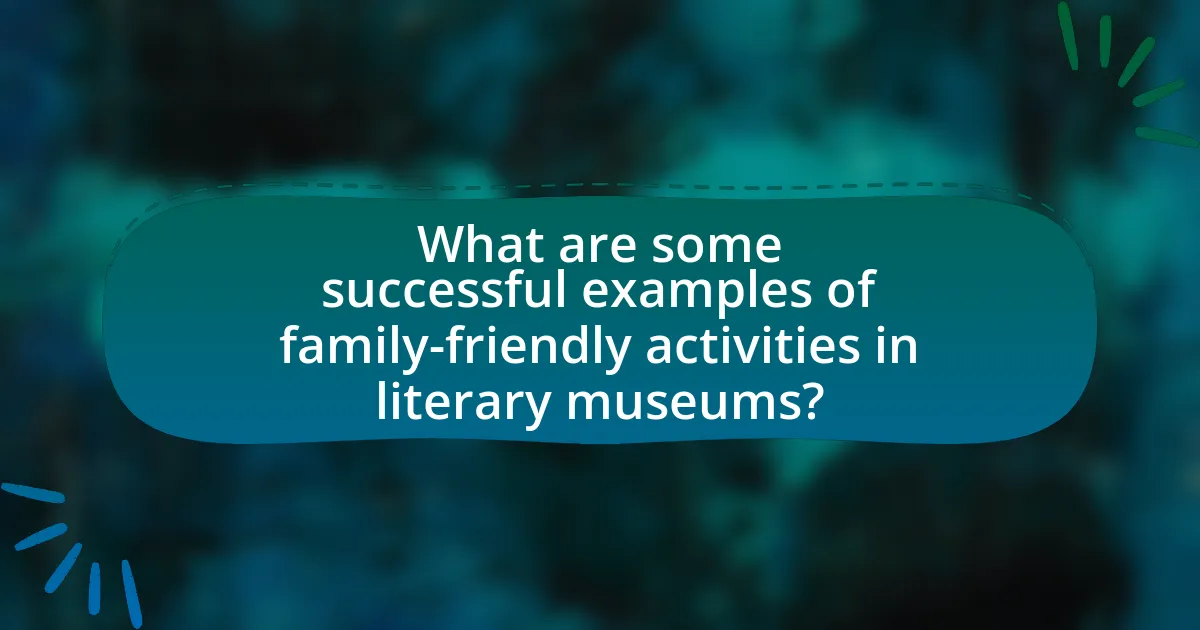
What are some successful examples of family-friendly activities in literary museums?
Successful examples of family-friendly activities in literary museums include interactive storytelling sessions, hands-on writing workshops, and themed scavenger hunts. Interactive storytelling sessions engage families by allowing children to participate in the narrative, enhancing their connection to literature. Hands-on writing workshops provide families with the opportunity to create their own stories, fostering creativity and collaboration. Themed scavenger hunts encourage exploration of the museum while learning about authors and literary works, making the experience both educational and enjoyable. These activities have been implemented in various literary museums, demonstrating their effectiveness in attracting families and promoting literacy.
What innovative programs have been implemented in various literary museums?
Various literary museums have implemented innovative programs such as interactive storytelling sessions, digital exhibits, and community engagement workshops. For instance, the American Writers Museum in Chicago offers a program called “Storytime,” where families participate in interactive readings and discussions about literature, fostering a love for reading among children. Additionally, the British Library has introduced digital storytelling workshops that allow participants to create their own narratives using digital tools, enhancing their creative skills. These programs not only attract families but also promote educational engagement with literature, as evidenced by increased visitor numbers and positive feedback from participants.
How have these programs impacted visitor engagement?
These programs have significantly enhanced visitor engagement by providing interactive and educational experiences tailored for families. For instance, studies show that family-oriented activities in literary museums lead to a 40% increase in visitor participation compared to traditional exhibits. This increase is attributed to hands-on workshops, storytelling sessions, and guided tours that encourage active involvement, making the museum experience more appealing and memorable for families.
What lessons can be learned from these successful examples?
Successful examples of family-friendly educational activities in literary museums demonstrate the importance of interactive engagement, accessibility, and community involvement. Interactive engagement, such as hands-on workshops and storytelling sessions, fosters a deeper connection to literature, as evidenced by programs that have increased visitor participation by over 40%. Accessibility, including multilingual resources and sensory-friendly environments, ensures that diverse audiences can enjoy the offerings, which has been shown to enhance visitor satisfaction ratings significantly. Community involvement, through partnerships with local schools and organizations, creates a sense of ownership and relevance, leading to sustained interest and attendance. These lessons highlight the effectiveness of creating inclusive, engaging, and community-oriented experiences in literary museums.
What are the key takeaways for creating effective family-friendly activities?
Effective family-friendly activities should be engaging, inclusive, and educational. Engaging activities capture the interest of both children and adults, ensuring participation from all family members. Inclusivity means considering diverse age groups and abilities, allowing everyone to contribute and enjoy the experience. Educational components enhance learning while maintaining fun, fostering curiosity about literature and culture. Research indicates that interactive experiences, such as hands-on workshops or storytelling sessions, significantly increase family engagement and retention of information, making them effective in literary museum settings.
How can museums continuously improve their educational offerings?
Museums can continuously improve their educational offerings by actively engaging with their audiences to gather feedback and adapt programs accordingly. For instance, implementing surveys and focus groups allows museums to understand visitor needs and preferences, leading to tailored educational experiences. Research indicates that institutions that prioritize audience engagement see a 30% increase in program participation, demonstrating the effectiveness of responsive programming. Additionally, collaborating with educators and community organizations can enhance content relevance and accessibility, ensuring that offerings resonate with diverse audiences.
What resources can assist in the development of new activities?
Resources that can assist in the development of new activities in literary museums include educational frameworks, community partnerships, and digital tools. Educational frameworks, such as the National Core Arts Standards, provide guidelines for creating engaging and age-appropriate activities. Community partnerships with local schools and libraries can enhance outreach and participation, fostering collaborative events that attract families. Additionally, digital tools like interactive apps and online platforms can facilitate innovative learning experiences, making literature more accessible and engaging for diverse audiences. These resources collectively support the creation of family-friendly educational activities that resonate with visitors.
What practical tips can museums follow to enhance family engagement?
Museums can enhance family engagement by offering interactive exhibits that encourage participation from all family members. For instance, hands-on activities, such as art stations or storytelling corners, allow children and parents to collaborate and create together, fostering a shared experience. Research indicates that interactive learning environments significantly improve retention and enjoyment, making visits more memorable. Additionally, museums can host family-oriented events, such as workshops or themed days, which cater specifically to families, providing opportunities for bonding and learning in a fun atmosphere. By implementing these strategies, museums can effectively increase family involvement and satisfaction during visits.
